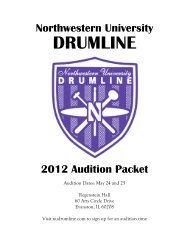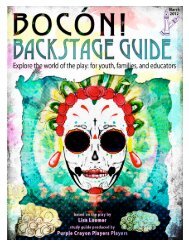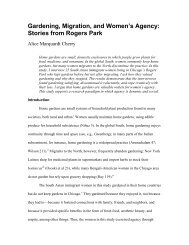research - Associated Student Government, Northwestern University
research - Associated Student Government, Northwestern University
research - Associated Student Government, Northwestern University
You also want an ePaper? Increase the reach of your titles
YUMPU automatically turns print PDFs into web optimized ePapers that Google loves.
ABSTRACTclaiming ties to the Capetian rulers. Scholars have demonstratedthat the two churches were in close dialogueduring the mid-twelfth century. 3 Why, then, did themonks of St-Germain-des-Prés take the unusual step ofcommissioning the effigy of a queen for their church,given that St-Denis commissioned no counterpart?Rendered in a hybrid of mosaic and enamel techniques(fig. 1), the tomb slab of Frédégonde baffles thefew scholars who examine it. In marked contrast to therest of the effigies in St-Germain-des-Prés and St-Denis,the effigy is two-dimensional. Although the slab is acenotaph, commissioned by the monks for a long-deadqueen, the tomb slabs of several contemporary queenssuggest points of comparison. 4 My <strong>research</strong> thus currentlypositions the anomalous effigy in a narrative ofCapetian queenship. The slab material (precious stonesand copper) resonates with propagandistic attempts torepresent queens as saintly figures; in the theologicalrhetoric of the day, saints were metaphorically describedas possessing bodies of “gold, silver, and preciousgems.” 5Frédégonde’s position as a polarizing figure in thedynastic history of the Merovingians makes this attemptall the more unusual. A palace maid and concubine, sheovercame her lowly station to marry King Chilperic Iaround 568. The monks at St-Germain-des-Prés wouldhave interpreted her legacy through historical accountsthat figured her as a monstrous exemplar; Gregory ofTours, in his widely read account, described her as amurderous, adulterous woman who “showed no fearof God.” 6 Significantly, however, chronicles such asthe later Liber Historiae Francorum also emphasizedFrédégonde’s role as the matriarch whose machinationsensured both the royal prestige of St-Germain-des-Présand the survival of her children, who constituted thesurviving line of the Merovingian kings. Her burial inSt-Germain-des-Prés presented the 12th-century monkswith an incentive to rehabilitate her legacy.Ultimately, the tomb will offer significant insightsinto how scholars map questions of style and femininityonto the mid-12th century intersection of art and death.Even as the monks chose to render Frédégonde’s cenotaphin the anomalous format described above, theycommissioned three-dimensional effigies for her husbandand male counterparts. Clearly, the project of representingand rehabilitating a dead female queen suggesteda new challenge for the monks; one they tackledin a highly distinctive way that can tell us much.Notes1 The study resulting in this paper was assisted by a grant from the UndergraduateResearch Grant Program which is administered by <strong>Northwestern</strong> <strong>University</strong>’s Office ofthe Provost. However, the conclusions, opinions, and other statements in this paperare the author’s and not necessarily those of the sponsoring institution.2 See Erwin Panofsky’s landmark publications Gothic Architecture and Scholasticism(New York, NY: Meridian Books, 1957) and Abbot Suger on the Abbey Church of St.Denis and its Art Treasures (Princeton, NJ: Princeton <strong>University</strong> Press, 1946).3 See William Clark, “Defining National Historical Memory in Parisian Architecture(1130-1160),” In Grégoire de Tours et l’espace gaulois: actes du congrés international,Tours, 3-5 novembre, 1994 (1997): 345-58.4 See Kathleen Nolan, “The Tomb of Adelaide of Maurienne and the Visual Imagery ofCapetian Queenship,” in Capetian Women, ed. Nolan (New York: Palgrave MacMillan,2003), 45-76.5 Jacques Le Goff, The Birth of Purgatory, trans. Arthur Goldhammer (Chicago:<strong>University</strong> of Chicago Press, 1984), 142.6 Gregory of Tours, The Merovingians, ed. and trans. Alexander Callander Murray(Peterborough: Broadview Press, 2006), 149.VOLUME 7, 2011-2012NORTHWESTERN UNDERGRADUATE RESEARCH JOURNAL19











